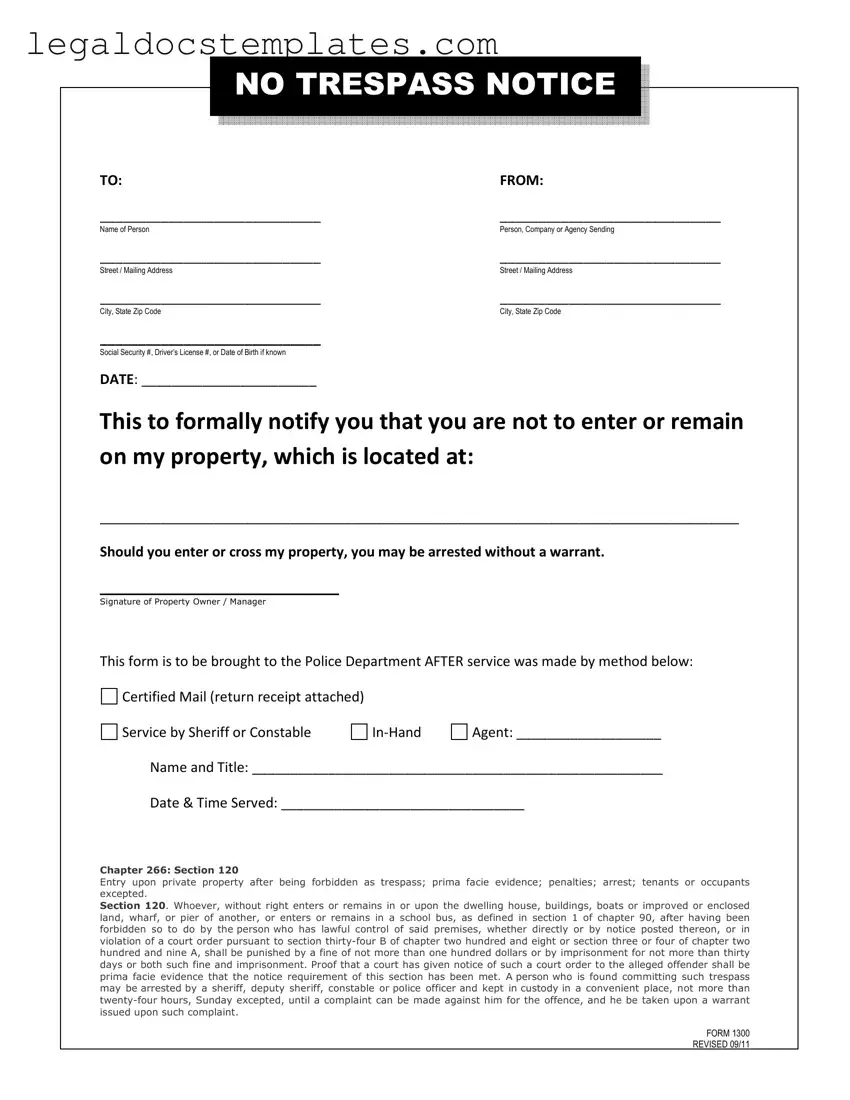What is a No Trespassing Letter and why is it used?
A No Trespassing Letter, also known as a trespass notice or letter of no trespass, is a formal document used by a property owner or occupier to warn an individual or group to stay off their property. It serves as a clear, legal indication that the person is not welcome on the property and that any unauthorized entry in the future could lead to legal action, including arrest without a warrant. This letter is often used as a preventative measure to stop unwanted visits or to escalate an ongoing issue with trespassers.
How can I deliver a No Trespassing Letter?
Delivering a No Trespassing Letter can be done through several methods, each with its own level of formality and proof of receipt:
-
Certified Mail (return receipt attached):
This method provides proof that the recipient received the letter, as they must sign for it upon delivery.
-
Service by Sheriff or Constable:
Using law enforcement or a legal official to deliver the letter adds an official tone to the notice and ensures the recipient cannot deny receipt.
-
In-Hand Agent:
This involves personally handing the letter to the recipient or someone who can legally accept it on their behalf. This method should be documented with the name and title of the agent, along with the date and time of service.
The No Trespassing Letter should be clear, concise, and include specific details such as:
-
TO:
The name(s) of the individual(s) being warned.
-
FROM:
The name(s) of the property owner(s) or occupier(s).
-
The address or precise description of the property in question.
-
The date the letter was written and served.
-
A warning stating that any unauthorized entry onto the property may result in arrest.
-
Details on how the letter was delivered (e.g., certified mail, in-person by a sheriff, etc.).
Providing specific details helps reinforce the seriousness of the warning and ensures there is no misunderstanding about the terms set forth.
Do I need to have the No Trespassing Letter notarized?
While not typically required, having the No Trespassing Letter notarized can add an additional layer of formality and authenticity to the document. It can help in proving that the signatures on the letter are legitimate, especially if the situation escalates to legal proceedings. However, it's best to consult with legal counsel to understand the requirements and benefits specific to your situation.
Can a No Trespassing Letter be used for any type of property?
Yes, a No Trespassing Letter can be used for various types of property, including residential, commercial, and undeveloped land. The key is that the individual issuing the letter must have legal authority over the property, either as the owner or a legally designated occupier.
Is a No Trespassing Letter legally binding?
A No Trespassing Letter itself serves as a warning and, when properly documented, can be used as evidence of this warning if legal action needs to be taken. On its own, it does not carry the force of law, but if the warning is ignored and trespassing occurs, the letter helps establish that the trespassed was knowingly in violation, making any resulting legal actions more straightforward.
What should I do after sending a No Trespassing Letter?
After sending a No Trespassing Letter, it's important to document everything meticulously. This includes keeping a copy of the letter, the method of delivery, and any receipts or acknowledgments of delivery. If the individual disregards the letter and trespasses on your property, you may then choose to involve law enforcement or pursue legal action, using the letter as part of your evidence.
Can I write a No Trespassing Letter myself, or do I need a lawyer?
It is entirely possible to write a No Trespassing Letter on your own, especially for straightforward situations. However, it might be wise to consult with or hire a lawyer if the situation is complex or if there's a history of disputes with the individual. A lawyer can ensure that the letter is legally sound and more likely to be effective in preventing future incidents.

